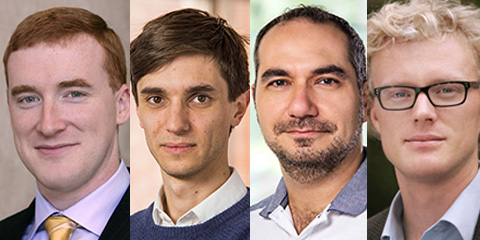By Molly A. Seltzer
The Andlinger Center for Energy and the Environment has funded two projects through its grant for Innovative Research in Energy and the Environment. One seeks to understand the impacts of the COVID-19 pandemic on cities in hopes of building infrastructure that is more resilient to multiple shocks. The other aims to investigate the flow of air and water around offshore wind turbines to better design the wind farms for maximum power output.
Redesigning cities for resilience postpandemic

Eighty-percent of GDP globally is generated in cities, and almost 60% of the world’s population lives in urban areas. Anu Ramaswami, the Sanjay Swani ’87 Professor of India Studies, professor of civil and environmental engineering and the High Meadows Environmental Institute, and director of the M.S. Chadha Center for Global India at the Princeton Institute for International and Regional Studies, is interviewing city managers in India and the United States to answer the question of how urban infrastructure and peoples’ behavior and preferences were impacted by the pandemic. Elke Weber, the Gerhard R. Andlinger Professor in Energy and the Environment, professor of psychology and the School of Public and International Affairs and associate director for education at the Andlinger Center, is surveying citizens in the two countries on their pandemic experiences. The researchers intend to explore the effects of the COVID-19 pandemic on cities and, specifically, the impacts on multiple interacting physical and social provisioning systems, including public transit, green spaces, food supply, health care, community governance, waste management and other areas. The goal is to collect individual and policy-level data to help inform decision making and cultivate resilience in urban communities. Identifying these policy needs from citizens and policy makers is expected to help lay the foundation for redesigning urban infrastructure in a post-pandemic future. The researchers eventually hope to create tools and engineering solutions to deal with the impacts, for example redesigning local food supply to reduce the prevalence of hunger or investing in transportation services that can be dispatched in times of need. The researchers said these innovations could help cities facing budget shortfalls find solutions that provide benefits across multiple urban systems.
The Andlinger Center project support was matched by the Chadha Center for Global India at the Princeton Institute for International and Regional Studies.
Optimizing offshore wind farm design

As states look to offshore wind to meet clean energy goals, how these wind farms are designed becomes all the more important. New Jersey, for example, has committed to developing enough offshore wind capacity to power 3.2 million homes by 2035. But one detail that is not well understood is how to design wind farms so that the wind flows efficiently between turbines. Princeton researchers are developing methods to account for the “wake effect” that upstream turbines have on those downstream. Predicting these wakes for offshore wind farms is difficult due to the complex energy exchanges between the atmosphere, sea surface, and the turbines themselves. Michael E. Mueller, associate professor of mechanical and aerospace engineering, is leading the project to develop novel computational fluid dynamics modeling for the coupled behavior of the sea surface and wind turbine wakes to inform wind farm design. Luc Deike, assistant professor of mechanical and aerospace engineering and the High Meadows Environmental Institute is a collaborator, along with Elie Bou-Zeid and Marcus Hultmark. Deike will develop the model to predict sea wave dynamics, which will be combined with atmospheric fluid dynamics models developed by Bou-Zeid, professor of civil and environmental engineering. Hultmark, associate professor of mechanical and aerospace engineering, will lead an experimental effort to validate these models. He will emulate the actual conditions of the wind turbine using a wind tunnel designed and built in his lab to compare against the computational simulations.
Hultmark, Bou-Zeid, and Deike and were researchers on a past project supported by the Andlinger Center to do experimental research on a one-of-a-kind superscale wind tunnel for modeling wind flows, which is under construction on Princeton’s Forrestal campus. The three are also coauthors on the Andlinger Center’s Energy Technology Distillate, Wind Power, a report that reviews the current technology and economics of wind power. It is available to download for free on the Andlinger Center’s website.